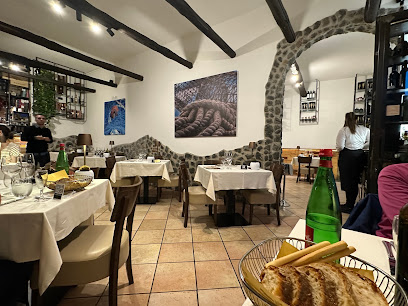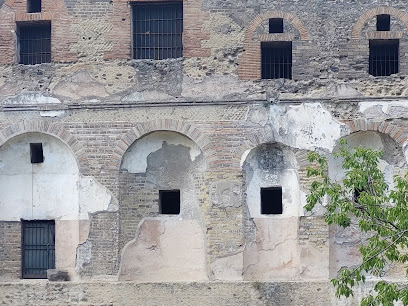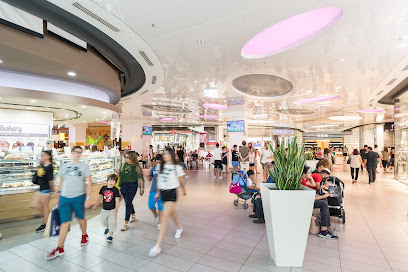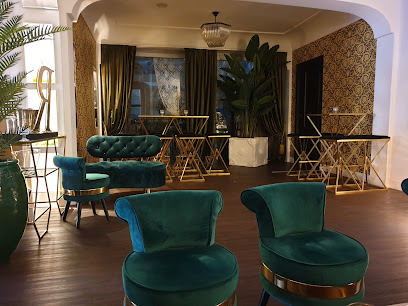
House of the Vettii: A Window into Ancient Roman Luxury
Explore the House of the Vettii in Pompeii, Italy: A beautifully preserved Roman home that offers a captivating glimpse into the opulent lifestyle of ancient elites.
Nestled within the ruins of Pompeii, the House of the Vettii offers a rare glimpse into the opulent lifestyle of wealthy Romans before the catastrophic eruption of Mount Vesuvius in AD 79. This well-preserved domus showcases the rich artistry and sophisticated tastes of its former owners, Aulus Vettius Restitutus and Aulus Vettius Conviva, who were believed to be freedmen turned wealthy merchants. As you wander through the House of the Vettii, you will be captivated by its stunning frescoes, which adorn the walls with vibrant depictions of mythological scenes, daily life, and intricate patterns. These frescoes are considered some of the finest examples of Roman wall painting, offering insight into the cultural and artistic values of the time. The peristyle garden, with its elegant fountains and statues, provides a tranquil space that reflects the importance of nature and leisure in Roman domestic life. The layout of the house, with its atrium, triclinium, and cubicula, reveals much about the social structure and daily activities of its inhabitants. Each room tells a story, from the grand reception areas designed to impress guests to the more private quarters that hint at the intimate lives of the Vettii family. Whether you are a history enthusiast, an art lover, or simply a curious traveler, the House of the Vettii offers a fascinating journey through time, allowing you to experience the grandeur and sophistication of ancient Pompeii.
Local tips in House of the Vettii
- Visit early in the morning to avoid the crowds and enjoy a more peaceful experience.
- Take a guided tour to fully appreciate the historical and artistic significance of the frescoes and architecture.
- Wear comfortable shoes, as the terrain can be uneven and you will be doing a lot of walking.
- Bring water and sun protection, especially during the hot summer months.
- Combine your visit with other nearby attractions in Pompeii, such as the Forum and the Amphitheater, for a comprehensive understanding of the ancient city.
House of the Vettii: A Window into Ancient Roman Luxury
Nestled within the ruins of Pompeii, the House of the Vettii offers a rare glimpse into the opulent lifestyle of wealthy Romans before the catastrophic eruption of Mount Vesuvius in AD 79. This well-preserved domus showcases the rich artistry and sophisticated tastes of its former owners, Aulus Vettius Restitutus and Aulus Vettius Conviva, who were believed to be freedmen turned wealthy merchants. As you wander through the House of the Vettii, you will be captivated by its stunning frescoes, which adorn the walls with vibrant depictions of mythological scenes, daily life, and intricate patterns. These frescoes are considered some of the finest examples of Roman wall painting, offering insight into the cultural and artistic values of the time. The peristyle garden, with its elegant fountains and statues, provides a tranquil space that reflects the importance of nature and leisure in Roman domestic life. The layout of the house, with its atrium, triclinium, and cubicula, reveals much about the social structure and daily activities of its inhabitants. Each room tells a story, from the grand reception areas designed to impress guests to the more private quarters that hint at the intimate lives of the Vettii family. Whether you are a history enthusiast, an art lover, or simply a curious traveler, the House of the Vettii offers a fascinating journey through time, allowing you to experience the grandeur and sophistication of ancient Pompeii.
Unmissable attractions to see
Foro di Pompei
Explore the ancient ruins of Foro di Pompei, a UNESCO World Heritage site, where history and culture converge in an extraordinary journey.

House of the Faun
Explore the House of the Faun, an archaeological masterpiece in Pompeii, showcasing stunning Roman art and architecture amidst ancient ruins.

House of the Vettii
Discover the House of the Vettii in Pompeii, where exquisite frescoes and luxurious Roman architecture await history aficionados and curious travelers.

House of the Tragic Poet
Explore the House of the Tragic Poet in Pompeii, a stunning archaeological site showcasing vibrant frescoes and the rich history of ancient Roman life.

House of Venus in the Shell
Discover the exquisite beauty and rich history of the House of Venus in the Shell, a captivating landmark in the heart of Pompeii.

Casa del Centenario
Explore the magnificent Casa del Centenario in Pompeii, a historical landmark that reveals the grandeur of ancient Roman life through its stunning architecture and art.

Essential places to dine
Ristorante Pizzeria IMatti
Experience exquisite Italian flavors at Ristorante Pizzeria IMatti in Pompei—home to mouthwatering pizzas and authentic regional dishes.

La Bettola Del Gusto
Discover authentic Italian cuisine at La Bettola Del Gusto in Pompei, offering exquisite seafood, steak, and raw food dishes amidst a charming ambiance.

Mercato Pompeiano Restaurant
Experience the rich flavors of Italy at Mercato Pompeiano - a culinary delight in the heart of Pompei.

Garum Pompei - Ristorante - Enoteca
Discover exquisite seafood dining and gourmet experiences at Garum Pompei - where Italian tradition meets culinary innovation.

Stuzzico By Lucius
Experience authentic Italian cuisine at Stuzzico By Lucius in Pompei – where tradition meets flavor.

Ristorante Tiberius Pompei
Experience authentic Italian cuisine at Ristorante Tiberius in Pompei, where tradition meets modern dining in an inviting atmosphere.

Hortus Pompei, Restaurant & Garden Bar
Discover authentic Italian cuisine in a lush garden setting at Hortus Pompei – your perfect culinary retreat near ancient ruins.

Ristorante pizzeria Turistico
Discover authentic Italian flavors at Ristorante Pizzeria Turistico in Pompei – where every meal is a celebration of culinary tradition.

Ristorante Suisse
Experience authentic Italian cuisine at Ristorante Suisse in Pompei – where delicious meals meet historic surroundings.

Ristorante President Pompei
Experience fine dining at Ristorante President Pompei - savor exquisite Italian and Mediterranean flavors in a historic setting.

Markets, malls and hidden boutiques
Centro Commerciale La Cartiera
Explore the stylish Centro Commerciale La Cartiera in Pompei, a shopping paradise with diverse stores, delightful dining, and vibrant Italian culture.

House of the Vettii
Explore the House of the Vettii in Pompeii, a stunning archaeological site with captivating frescoes and rich Roman history.

House of the Tragic Poet
Explore the House of the Tragic Poet in Pompeii, an archaeological gem filled with stunning frescoes and rich history, revealing the essence of ancient Roman life.

B&B Domus Vettii Pompei
Experience the charm of Pompei at B&B Domus Vettii, your perfect base for exploring ancient ruins and indulging in local delights.

Cellini Gallery Cameos & Corals
Discover exquisite cameos and corals at Cellini Gallery in Pompei, where each piece embodies the artistry of Italian craftsmanship.

Casa Dei Vettii B&B
Discover the enchanting Casa Dei Vettii B&B in Pompei, where comfort meets history just moments away from the ancient ruins.

Essential bars & hidden hideouts
'Mericano (Pub - Steak House - Birreria) Pompei
Discover the perfect blend of local cuisine and craft beer at Mericano Pub in Pompei, where every meal is an unforgettable experience.

Open Bar Pompei
Experience the vibrant atmosphere of Open Bar Pompei, the perfect spot for refreshments and relaxation amid your Pompei adventures.

House of the Vettii
Explore the House of the Vettii, a stunning archaeological marvel in Pompeii, showcasing exquisite frescoes and ancient Roman luxury.

THE ROOF
Discover a cocktail paradise with stunning views at The Roof in Pompei, where every sip and bite tells a story of local flavors.

Vitium
Experience the essence of relaxation at Vitium, Pompei's premier bar tabac, where fine cigars and a cozy ambiance await.

Richness
Discover Richness Lounge in Pompei: Your cozy retreat for relaxation, music, and local charm after a day of exploring ancient wonders.

Bar Bouvette Misteri Di Vorro Luig
Discover the charm of Bar Bouvette Misteri Di Vorro Luig in Pompei, where refreshing drinks meet a cozy atmosphere amidst ancient history.

Local Phrases
-
- HelloCiao
[chow] - GoodbyeArrivederci
[ah-ree-veh-dehr-chee] - YesSì
[see] - NoNo
[noh] - Please/You're welcomePer favore/Prego
[pehr fah-voh-reh/preh-goh] - Thank youGrazie
[grah-tsyeh] - Excuse me/SorryScusa/Mi dispiace
[skoo-sah/mee dee-spyah-che] - How are you?Come stai?
[koh-meh stai] - Fine. And you?Bene. E tu?
[beh-neh. eh too] - Do you speak English?Parli inglese?
[pahr-lee een-gleh-zeh] - I don't understandNon capisco
[nohn kah-pee-scoh]
- HelloCiao
-
- I'd like to see the menu, pleaseVorrei vedere il menù, per favore
[vohr-ray veh-deh-reh eel meh-noo, pehr fah-voh-reh] - I don't eat meatNon mangio carne
[nohn mahn-joh kahr-neh] - Cheers!Salute!
[sah-loo-teh] - I would like to pay, pleaseVorrei pagare, per favore
[vohr-ray pah-gah-reh, pehr fah-voh-reh]
- I'd like to see the menu, pleaseVorrei vedere il menù, per favore
-
- Help!Aiuto!
[ah-yoo-toh] - Go away!Vai via!
[vah-ee vee-ah] - Call the Police!Chiamate la Polizia!
[kyah-mah-teh lah poh-lee-tsya] - Call a doctor!Chiamate un dottore!
[kyah-mah-teh oon doht-toh-reh] - I'm lostMi sono perso
[mee soh-no pehr-soh] - I'm illSto male
[stoh mah-leh]
- Help!Aiuto!
-
- I'd like to buy...Vorrei comprare...
[vohr-ray kohm-prah-reh] - I'm just lookingSto solo guardando
[stoh soh-loh gwahr-dahn-doh] - How much is it?Quanto costa?
[kwahn-toh koh-stah] - That's too expensiveÈ troppo caro
[eh troh-poh kah-roh] - Can you lower the price?Puoi abbassare il prezzo?
[pwoh-ee ahb-bahs-sah-reh eel preh-tsoh]
- I'd like to buy...Vorrei comprare...
-
- What time is it?Che ora è?
[keh oh-rah eh] - It's one o'clockÈ l'una
[eh loo-nah] - Half past (10)E mezza (dieci)
[eh meh-tzah (dyeh-chee)] - MorningMattina
[maht-tee-nah] - AfternoonPomeriggio
[poh-meh-ree-joh] - EveningSera
[seh-rah] - YesterdayIeri
[yeh-ree] - TodayOggi
[oh-jee] - TomorrowDomani
[doh-mah-nee] - 1Uno
[oo-noh] - 2Due
[dweh] - 3Tre
[treh] - 4Quattro
[kwah-troh] - 5Cinque
[cheen-kweh] - 6Sei
[seh-ee] - 7Sette
[seh-tteh] - 8Otto
[ot-toh] - 9Nove
[noh-veh] - 10Dieci
[dyeh-chee]
- What time is it?Che ora è?
-
- Where's a/the...?Dov'è un/il...
[doh-veh oon/eel] - What's the address?Qual è l'indirizzo?
[kwahl eh leen-dee-reet-soh] - Can you show me (on the map)?Puoi mostrarmi (sulla mappa)?
[pwoh-ee mohs-trahr-mee (sool-lah mahp-pah)] - When's the next (bus)?Quando passa il prossimo (autobus)?
[kwahn-doh pahs-sah eel prohs-see-moh (ow-toh-boos)] - A ticket (to ....)Un biglietto (per ....)
[oon beel-lyet-toh (pehr)]
- Where's a/the...?Dov'è un/il...
History of House of the Vettii
-
The House of the Vettii, one of the most famous and well-preserved villas in Pompeii, dates back to the 1st century AD. It was owned by two freedmen, Aulus Vettius Restitutus and Aulus Vettius Conviva, who amassed their wealth through the lucrative trade of wine. The house is a prime example of Roman domestic architecture, featuring elaborate frescoes and intricate mosaics that reflect the opulence of the owners' lifestyle.
-
The house showcases the transition from the typical atrium-style layout to a more open and luxurious design, emphasizing the importance of personal space and decoration in Roman homes. The atrium is adorned with stunning frescoes, including the famous 'Dionysian' scenes, which illustrate the cultural significance of wine and festivities in Roman society.
-
In AD 79, the catastrophic eruption of Mount Vesuvius buried Pompeii under a thick blanket of ash and pumice, effectively preserving the House of the Vettii and its contents. The sudden nature of the disaster allowed for an incredible snapshot of Roman life, capturing the intricate details of domestic life, art, and culture in the days leading up to the eruption.
-
The frescoes within the House of the Vettii provide significant insight into the cultural and social values of the time. Notably, the imagery often draws from mythology and represents themes of abundance, pleasure, and the divine, revealing the owners' aspirations and the broader societal emphasis on status and refinement in Roman culture.
-
The House of the Vettii was excavated in the mid-18th century and has since been a focal point for archaeologists studying Roman domestic life. Its discovery contributed to the broader understanding of Pompeii’s urban layout and the lifestyles of its inhabitants, establishing it as a vital site for heritage tourism and historical research.
House of the Vettii Essentials
-
The House of the Vettii is located within the archaeological site of Pompeii, easily accessible from various parts of the site. If entering through the main Porta Marina entrance, follow the Via Marina towards the Forum, then take a left on Via del Lupanare. The house is situated on the right-hand side. From the Porta Nocera entrance, head straight down Via Nola, and it will be on your left after a short walk.
-
Pompeii is primarily a pedestrian site, and the House of the Vettii is best explored on foot. The pathways are well-marked, and maps are available at the entrances. Bicycles are not permitted within the archaeological site. For those needing assistance, consider renting a mobility scooter or using the services of guided tours that often provide transportation options.
-
Pompeii is generally safe for tourists, but standard precautions are advisable. Stay within well-trafficked areas and avoid wandering into isolated parts of the site after hours. Be cautious of pickpockets in crowded areas, especially near entrances and popular sites. The archaeological site is monitored, but it's wise to remain vigilant.
-
In case of an emergency, contact local authorities by dialing 112 for police, fire, or medical emergencies. First aid stations are available within the site. For serious medical situations, the nearest hospital is in the nearby town of Scafati, approximately 3 km from Pompeii. It is advisable to have travel insurance that covers medical emergencies.
-
Fashion: Do wear comfortable walking shoes and dress appropriately for the weather. Don’t wear high heels or shoes that are not suitable for uneven surfaces. Religion: Do respect the historical significance of the site. Don’t climb on ruins or touch frescoes. Public Transport: Do use public transport to reach Pompeii, but don’t forget to validate your tickets. Greetings: Do greet staff and guides politely. Don’t engage in loud conversations. Eating & Drinking: Do carry water, especially in summer. Don’t eat or drink inside the archaeological site.
-
To experience the House of the Vettii like a local, consider visiting during the early morning or late afternoon to avoid crowds and enjoy a quieter atmosphere. Engage with knowledgeable local guides who can provide detailed insights into the history and significance of the house. Don’t miss the nearby Thermopolium, a fast-food establishment of ancient Pompeii, to get a taste of local Roman cuisine.
Nearby Cities to House of the Vettii
-
Things To Do in Herculaneum
-
Things To Do in Positano
-
Things To Do in Ravello
-
Things To Do in Amalfi
-
Things To Do in Sorrento
-
Things To Do in Naples
-
Things To Do in Capri
-
Things To Do in Matera
-
Things To Do in Bari
-
Things To Do in Rome
-
Things To Do in St. Peter's Square
-
Things To Do in Apostolic Palace
-
Things To Do in Vatican Necropolis
-
Things To Do in St. Peter's Basilica
-
Things To Do in Sistine Chapel








